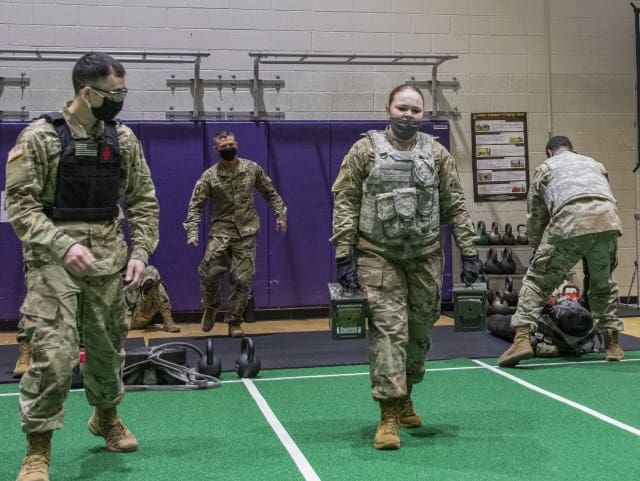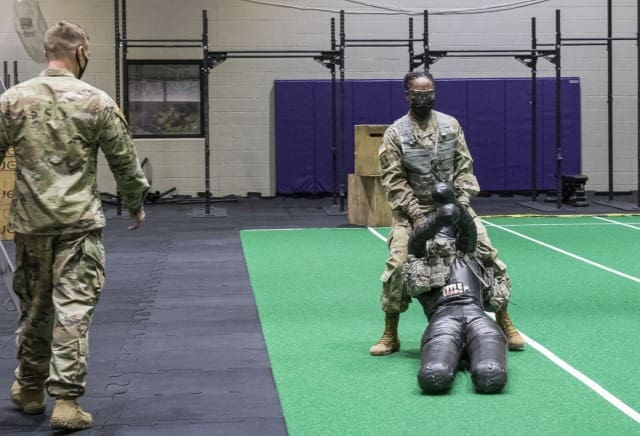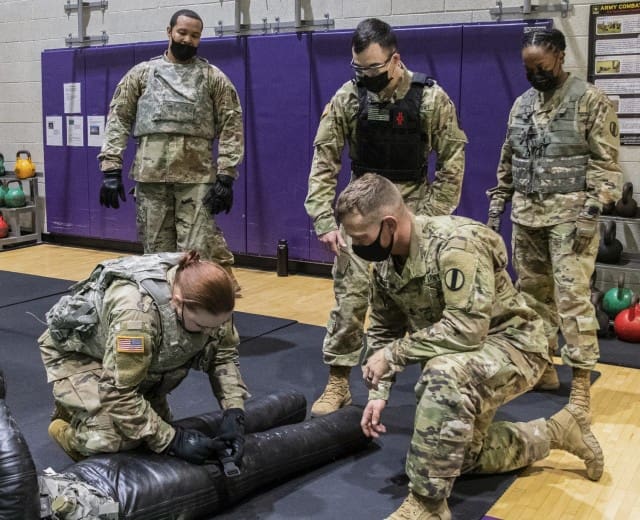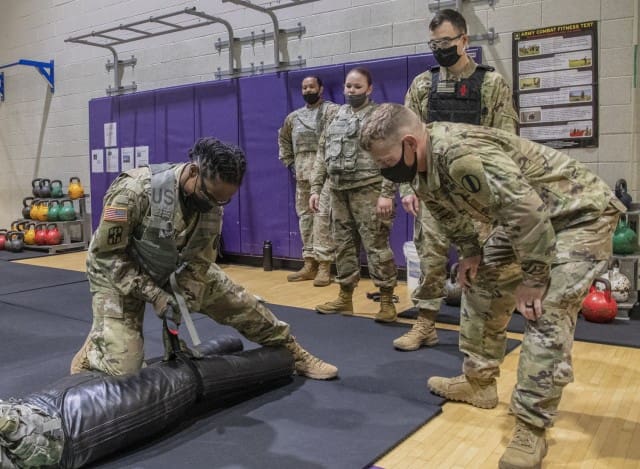FORT EUSTIS, Va. – The Army’s new physical fitness test, known as the Army Combat Fitness Test, or ACFT, is here to stay. Or at least some form of it, says Sgt. Maj. of the Army Michael A. Grinston. What some may overlook when making an opinion on the program is the “combat” aspect of the ACFT, which was designed to prepare Soldiers for combat and reduce injuries caused by physical fitness routines.

With that in mind, 2020 Drill Sergeant of the Year, Sgt. 1st Class Erik Rostamo, and a team of experts from the U.S. Army Center for Initial Military Training, brought realistic ACFT training to life here, Feb. 26.
The “sprint, drag, carry” event of the ACFT is designed to simulate “sprinting” to aid an injured Soldier, then “dragging” a Soldier out of harm’s way when under fire, and “carrying” ammunition to a fighting position on the battlefield. For the ACFT, two 45-pound weights are configured as a “sled” for dragging purposes, while Soldiers are required to wear the Army Physical Fitness Uniform, or APFU. For the training Rostamo and the CIMT team designed for this day, a 140-pound dummy was used to represent an actual Soldier, and participants performed the task while wearing their Army Combat Uniform, or ACU. In addition, an extra twist was added – after completing the “sprint, drag, carry,” participants were required to apply a field tourniquet to the dummy, which simulated a wounded Soldier requiring immediate first aid.

“This exercise showed the Soldiers why the Army is moving toward holistic fitness, and developing the ‘Soldier Athlete,’” Rostamo said. “All Soldiers, regardless of their MOS [military occupational specialty], never know when they will find themselves on the battlefield.”
Soldiers participating in the training weighed in with their thoughts.
“It was amazing training,” said Staff Sgt. Jacob Walker, 2nd Battalion, 210th Aviation Regiment. “Unless you’re in a combat arms MOS, and your leaders go out of their way to train these tasks, it’s a perishable skill. I will be adding this type of training to my physical training plan when I get back to FORSCOM [Forces Command].”
All Soldiers, whether they are a transportation Soldier, a mechanic, or an infantryman, must be physically able to deploy anywhere in the world at a moment’s notice… This was Rostamo’s mantra for the day.
“I liked it. It drove home the reality of why we are training,” said Sgt. 1st Class Mario Rodriguez, 128th Aviation Brigade. “The dummy we were dragging instead of the weights provided extra motivation as a simulated battle buddy.”
The added field tourniquet element at the end of the “sprint, drag, carry” was clearly noticed by participating Soldiers who were winded and exhausted after the event. They had to compose themselves in order to successfully administer the field tourniquet and appreciated the challenge.

“I enjoyed it. I feel it was a great opportunity to connect the ACFT to actual combat training,” said Staff Sgt. Hillary Hernandez, 2nd Battalion, 210th Aviation Regiment. “I look forward to taking this training with me to use with my future Soldiers.”
TRADOC’s senior enlisted adviser, Command Sgt. Maj. Daniel T. Hendrex, participated in the training and shared his firsthand knowledge of providing first aid on a battlefield.
“This event was an excellent way to connect the importance of functional fitness requirements to a scenario that is reality on today’s modern battlefield,” Hendrex said. “Conducting the “sprint, drag, carry,” but with a 140-pound dummy, weighted ammo cans, and full kit, ending with the application of a field tourniquet, was an eye opener for everyone.”
Hendrex pointed out this also reinforces an important principle, “if the wounded are able, have them move to you.”
Conducting multiple repetitions of this skill in training is the preferred method of learning, and placing a medical task at the end is a great way for everyone to recognize its importance, Hendrex emphasized.

“The energy within the group is what motivated me,” said Pfc. Savanna Pendergrass, 10th Transportation Battalion. “This simulation gave me a true understanding of what it is like on the battlefield.”
By David Overson, TRADOC Communication Directorate


No helmets, no weapons, slick vests. Definitely just the crawl phase. Try again.
TLB
What started out as Ageless, Genderless and Combat focused has not devolved into a complicated APFT. Stick to Combat focused tasks in full armor and stop tiptoeing through the tulips.
Might as well revise the APFT and make the ACFT a go/no-go event with a far less complicated scoring system. A full days pay for reservists to complete an ACFT (because you know itll take close to 3 hours for a company, plus paperwork) is an extraordinary waste of valuable time. A well-run APFT can be knocked out before first formation; the ACFT is going to cut into those very crucial leadership meetings right after first formation.
“Very crucial leadership meetings.” Thanks, I needed a laugh!
Damned straight, maybe even do it outdoors. This stuff is minimum application to tick a box and only breeds the false mentality of them thinking they know what they’re doing. It’s basically half a cross-fit warm up.
Why not just do it properly so it matters?
Noticed they are also working across the dummy for the injury and kneeling on the “non-injured” leg instead of on the artery to slow blood flow while you are putting on the tourniquet. I agree, this is a “check the box” effort
Realistically, throwing that knee in the injured side isnt going to do anything except make you reach across places and slow you down when prepping and needing to grab things, pelvic instability (that occurs in a BUNCH of explosives related injuries) aside…TCCC changes have just been amended over the years to stop throwing knees into patients because of that.
Makes it even worse then – she’s just kneeling on him for no reason now lol
Looks like that training dummy at 140 lbs was a little on the light side. It must have lost its plate carrier, combat loadout of full magazines (7 each), grenades, water, and other things to reduce that much weight. If, the Canadian Armed forces can do it in full battle gear for the past 8 years we can also.
The Canadian Armed Forces (CAF) implemented an updated military fitness program in April, 2013.
Souces:
https://www.cfmws.com/en/aboutus/psp/dfit/fitness/pages/force-combat.aspx
https://vimeo.com/201988112
https://www.youtube.com/watch?v=COOcR6OL_cA
” after completing the “sprint, drag, carry,” participants were required to apply a field tourniquet to the dummy, which simulated a wounded Soldier requiring immediate first aid.” These are basic Everyday Life Saving Skills that can be used not just in combat but stateside at a motor vehicle/ industrial or everyday at home accident. I do agree that the PT we did before had NOTHING to do with being combat ready, so I hope this at least helps or starts to get people in a proper mindset. Once again a great concept that is not being properly executed.
Drag a soldier in full gear across 30 meters of terrain. Then come back and tell me what you got wrong.
A 140lb dummy? What’s the percentage of Soldiers that weigh only 140lbs in full kit? Id say close to zero….
I retired right before all these new fitness standards were implemented. Id be interested in know them amount of time it takes to administer these events to a company sized element.
Here’s my two cents. Keep both the ACFT (dropping the two mile run and pushups) and the APFT (maybe add chin-ups like the RPFT), like the marines with their PFT and CFT. As a commander the endurance focused APFT tells me more about how hard I can push individual Soldiers of Platoons (based on their average scores) whereas a the ACFT gives me a slightly better insight into an individual SMs readiness for combat.
Both tests have their strengths and weaknesses….so keep both make both an annual requirement and move on.
Just my thoughts.
Just like marksmanship…..
Tests can’t be designed for combat.
Tests don’t improve performance.
Tests don’t improve the quality of training.
They distract from the real problem and create the illusion of progress. Their only purpose should be to measure – not simulate!
See your point but disagree.
Soldiers weren’t supposed to “train the test” for the APFT but I always did. I struggled with pushups and running, so 8-12 weeks before APFT guess what I did? Lots of extra pushups and running.
So now Soldiers know they’ll be tested in deadlifts, sprint-drag-carry, and 2 mile run (among others).
Guess what they’ll start doing 8-12 weeks prior to test?
I’d argue a Soldier who spends 12 weeks improving his deadlift and power throws will probably be stronger than a Soldier who spends 12 weeks improving his pushups and situps.
No one in the infantry is still doing the Friday 10 mile battalion run in flak jackets like we did in West Germany in the Fulda Gap. If you failed that battalion 10 mile flak jacket run, you would have remedial training. We do not need to do retrograde operations any more in the Army. No need to for it. Our doctrine has changed. It is protection over mobility now. You could not do retrograde operations with all the gear an infantryman has to carry on today’s battlefield.
The 2 mistakes with ACFT is no one is required to perform it in full battle gear and no 10 to 12 mile road march is included. I guess they wanted more soldiers to pass the ACFT.
I get that it comes from a lot further up, so I won’t blame TRADOC. But, performing a fitness test in cloth face masks is EXACTLY the type of clown shoes ridiculousness that makes you simultaneously laugh at, and cry for, our military.
100% Utah! Couldn’t agree w/ you more, not to mention the above comments on dummy simulation and slicked out soldiers. Pathetic!